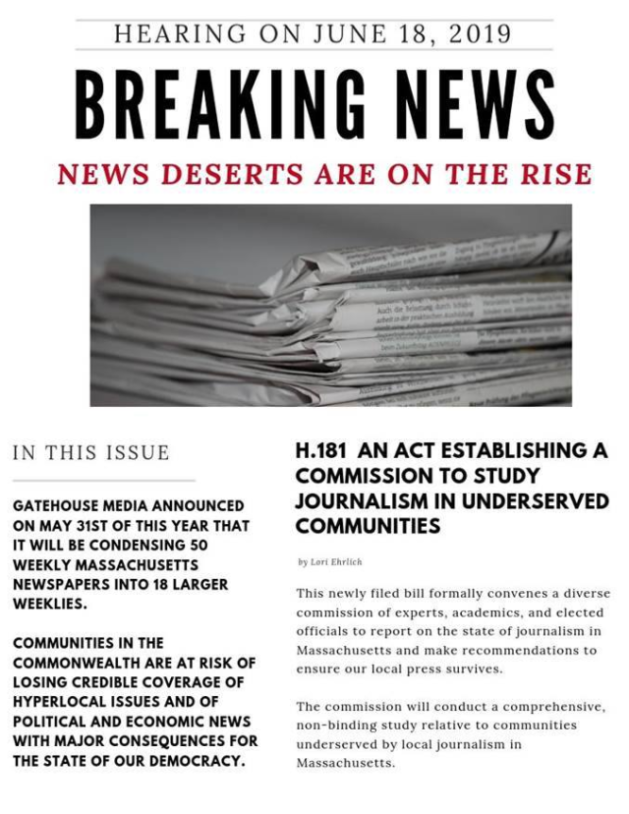
Previously published at WGBHNews.org.
The state of local journalism is grim — and the hedge funds that have scooped up hundreds of newspapers over the past decade have made things even worse than they otherwise might be.
That’s the conclusion of a new report from the University of North Carolina. Titled “The Expanding News Desert,” the study finds that corporate chains controlled by private equity and hedge funds cut more deeply, shut down more papers, and demonstrate less regard for journalism’s civic mission than was the case with “the historic practices of traditional print newspaper companies.” Here’s how the report’s author, Penelope Muse Abernathy, the Knight Chair in Journalism and Digital Media Economics at UNC, describes the strategies pursued by what she calls these “new media barons”:
The standard operating formula often included aggressive cost-cutting, the adoption of advertiser-friendly policies, the sale or shuttering of under-performing newspapers, and financial restructuring, including bankruptcy. At the most extreme, their strategies have led to the closure of hundreds of local papers and diminished the important civic role of newspapers in providing reliable news and information that helps residents of a community make important decisions about governance and quality of life issues.
This has enormous implications for Greater Boston, where two leading hedge-fund-owned chains, GateHouse Media and Digital First Media, already control most of the local papers, and where a third, CNHI, has put its four dailies in the Merrimack Valley and on the North Shore up for sale. Those papers — The Eagle-Tribune of North Andover, The Daily News of Newburyport, The Salem News, and the Gloucester Daily Times — are at risk of falling into the hands of either GateHouse or Digital First, which are likely to double down on the deep cuts that have already been made.
Digital First, controlled by Alden Global Capital, currently owns three papers in Massachusetts — the Sentinel & Enterprise of Fitchburg, The Sun of Lowell, and its most recent acquisition, the Boston Herald. Although I’ve written about Digital First on several occasions previously (for instance, see this), I was struck in reading the UNC report by just how bad things are.
Digital First’s profit margin in 2017 was 17 percent, far higher than that of other newspaper companies, including GateHouse. And it achieved that margin by destroying newsrooms — in some cases literally. The newsroom at the Fitchburg paper was shut down last year, with the paper’s journalists being told to work out of their homes. In the suburbs of Philadelphia, reporters at two Digital First papers “must work remotely,” Abernathy writes, “because the Pottstown Mercury’s mold-infested newspaper building has been condemned.”
The top-line numbers at Digital First are breathtaking. Between 2012 and ’17, employment at 12 Digital First papers decreased by 52 percent, from 1,766 to 849, according to a survey conducted by the NewsGuild. Yet as bad as that period was for the newspaper business as a whole, the Bureau of Labor Statistics found that total newspaper employment dropped by about one-fourth from 2012 to 2016 — only about half the rate of journalistic job destruction at Digital First.
GateHouse, meanwhile, has expanded massively in recent years — from 379 newspapers with a total circulation of 3.1 million in 2014 to 451 papers and 4.3 million in circulation today. The company controls well over 100 community weeklies in Greater Boston and environs as well as dailies such as the Providence Journal, the Telegram & Gazette of Worcester, The MetroWest Daily News of Framingham, and The Patriot Ledger of Quincy. According to the UNC findings, GateHouse’s decimation of the ProJo, which it purchased in 2014, has been especially brutal:
By July 2018, newsroom employment had been cut by 75 percent, bringing the staffing levels below 100. According to the NewsGuild-CWA, there were fewer than 20 reporters and columnists responsible for covering both state and city government.
GateHouse has also embarked on a strategy of selling business and marketing services to advertisers through subsidiaries of its hedge-fund owner, Fortress Investment Group — “raising questions,” as the report puts it, “about the role of a local newspaper’s sales department in supporting local businesses.” Readers are fleeing GateHouse’s shriveled papers. Revenues, profits, and share prices are all down. All of that calls into question, Abernathy writes, whether GateHouse’s aggressive acquisition strategy is sustainable.
The depredations of Digital First and GateHouse are taking place amid the cratering of local journalism nationwide. Among the UNC report’s findings:
- About 60 daily newspapers and 1,700 weeklies have closed since 2004, an overall decline of about 25 percent.
- Nearly 200 of the 3,143 counties in the United States no longer have a newspaper. More than 2,000 counties have no daily paper.
- Residents in these “news deserts” — that is, areas without newspapers — “are generally poorer, older and less educated than the average American.”
What can be done about the decline of local journalism and the rise of predatory hedge-fund newspaper chains? There is no one answer. The report notes that LION Publishers (Local Independent Online News) counts about 525 local digital news operations, both for-profit and nonprofit. Some, such as the New Haven Independent, The Batavian of Batavia, New York, and VT Digger, a statewide project based in Montpelier, Vermont, do an outstanding job of covering local and regional news. Yet many such operations are tiny and, as the report notes, a 2015 survey found that one in four failed. Although you could argue that three in four surviving is actually a pretty good track record, that’s not nearly enough to water the news deserts that are spreading across the countryside.
“There is a compelling need,” Abernathy writes, “for philanthropic foundations, community activists, local government, concerned citizens and potential founders of nonprofit news organizations to work together from the beginning to identify communities most lacking coverage and the funding needed to sustain a start-up news organization in those communities.”
That would be a good start, as would programs to boost civic and media literacy, another recommendation of the report. Without quality local news, it’s hard for people to participate in their communities in a meaningful way — or even to understand why they should. Corruption runs amok. Apathy reigns. And the underpinnings of democracy rot away.
Talk about this post on Facebook.








